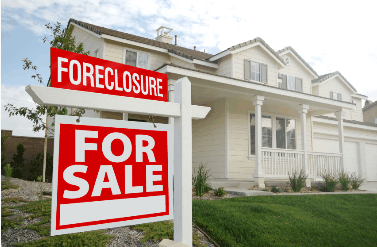
The US housing crash rolls on, with the Case-Shiller house price index showing prices fell in 19 of the 20 city markets it surveys in February. According to the Case-Shiller index, US home prices are now down 3.3% from a year ago (see below chart) and have fallen by around one-third since the housing bubble burst in 2006.
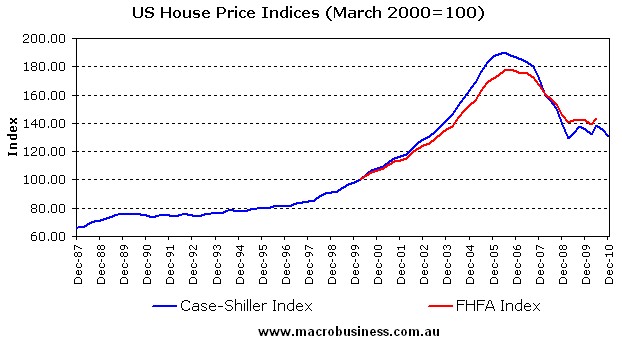
However, the broader FHFA national index, which measures home prices across 50 US states, has shown lower levels of volatility. This is because the US housing bubble/bust has been confined mostly to a minority of cities, as illustrated by the below chart, which compares the narrower 10-city Case-Shiller Composite Index against the FHFA 50-state House Price Index (chart courtesy of Carpe Diem).
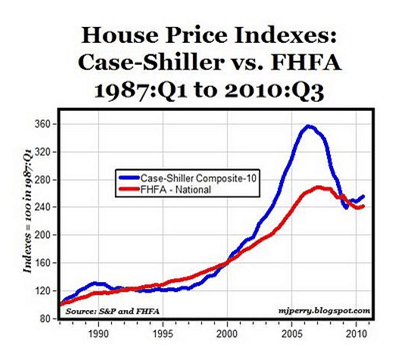
As you can see, the US housing bubble/bust has been most pervasive in the cities making up the Case-Shiller 10-city Composite Index, namely: Boston, Chicago, Denver, Las Vegas, LA, Miami, NYC, San Diego, San Francisco, and Washington D.C.. As a group, the remaining US markets have experienced smaller increases/decreases in prices.
Back in January, I explained how the extreme differences in price volatility between US cities/states was due predominantly to how these markets regulate land-use.
Housing markets where strict regulatory barriers are in place, such as urban growth boundaries, restrictive planning/zoning requirements, and minimum lot sizes, have been incapable of quickly and efficiently supplying low-cost housing. These supply constraints have ensured that increases (decreases) in housing demand have fed directly into higher (lower) prices instead of changes in new construction. The perceived land/housing shortages and rising prices during the upswing also encouraged speculative demand and ‘panic buying’ from first-time buyers, which assisted in driving home prices up even further. However, when the economy and sentiment soured in the wake of the financial crisis, causing housing demand to evapourate, prices collapsed in these supply-restricted markets.
By comparison, in housing markets with lighter-touch land-use regulations, low-cost housing was able to be built quickly and efficiently in response to rising demand. The rapid supply response prevented prices from rising dramatically, which also reduced speculative intent, since there was little prospect of achieving strong capital gains. And with house prices remaining relatively steady, ‘panic buying’ from first home buyers was less prevalent. Put simply, prices never rose as high or fell as far in the supply responsive markets.
To illustrate these points, consider the wild bubble/bust conditions experienced in markets identified by Demographia or the Brookings Institution as operating highly restrictive land use practices:
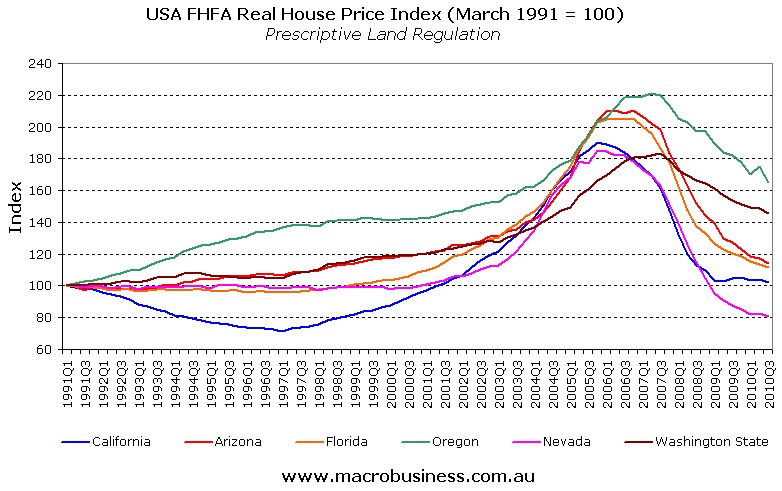
By contrast, markets adopting more liberal market-based approaches (‘more responsive land regulation’) have experienced lower levels of volatility and more moderate rises/falls in home values:
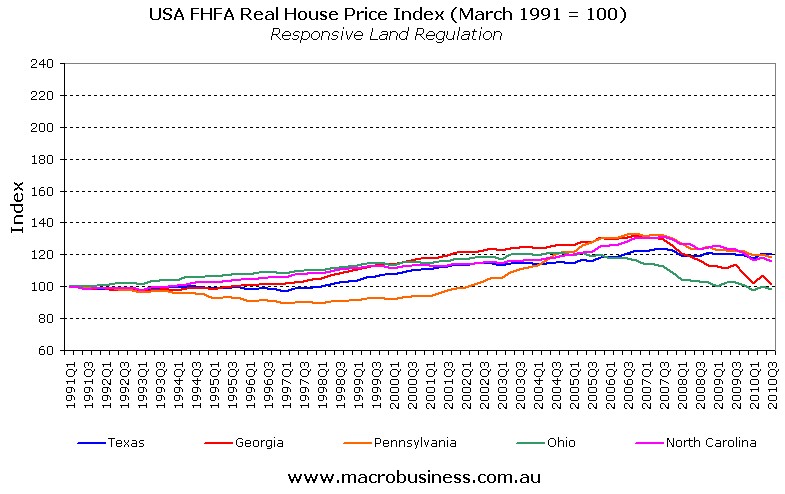
The findings are the same when the Case-Shiller city data is charted instead (click to view charts here and here).
Demand ain’t what it used to be:
An interesting feature of the US housing market was that the mainstream view at the height of the bubble was that prices were justified based on pervasive housing shortages and high levels of household formation (known as ‘underlying’ or ‘pent-up’ demand).
For example, California, which had experienced lower rates of home construction than Australia, was said to have a chronic housing shortage driven by continued high rates of household formation and inadequate construction.
And there are many other examples too, including:
- Neil Barsky, from Alson Capital Partners LLC, who made the following statements in the WSJ on 28 July, 2005 [my emphasis]:
“There is no housing bubble in this country. Our strong housing market is a function of myriad factors with real economic underpinnings: low interest rates, local job growth, the emotional attachment one has for one’s home, one’s view of one’s future earning- power, and parental contributions, all have done their part to contribute to rising home prices… What we do have is a serious housing shortage and housing affordability crisis.”
- James F. Smith, Director, Center for Business Forecasting, who in April 2005 argued that US housing demand would stay strong for years to come due to robust underlying demand [my emphasis]:
“There is no evidence of a housing “bubble” in the United States and housing demand should stay strong for years to come. Three major factors lead to this conclusion. First, the 77 million baby boomers are approaching the peak home ownership ages of 65-75 (over 83.0 percent versus a national average in 2004 of 69.0 percent). Second, immigrants, a growing share of the U.S. population, tend to buy houses ten years later than people born in the United States of the same income group and family size. Third, mortgage rates are not likely to go high enough (8.0 percent or more for 30-year fixed rate mortgages) to put a crimp in demand. Despite some areas of concern, overall homeowners’ equity is at record levels above $9 trillion. Delinquencies are still less than one percent of mortgages outstanding.”
- Samuel Lieber, President, Alpine Woods Capital Investors, who said in the WSJ on 12 April 2006 [my emphasis]:
“We don’t see a bubble. Historically, home prices just don’t go down nationwide unless we are in a significant recession… It’s employment that really counts. The underlying fundamentals of real estate are still very positive. Job creation and household formation drive housing.”
- Mark Vitner, Senior Economist, Wachovia said on 19 January 2006:
“Everybody is looking for evidence of a housing bubble…There is not a housing bubble. The supply had not kept up with demand.”
- And finally, who can forget this testimony from Ben Bernanke in 2005 [my emphasis]:
“House prices have risen by nearly 25 percent over the past two years. Although speculative activity has increased in some areas, at a national level these price increases largely reflect strong economic fundamentals, including robust growth in jobs and incomes, low mortgage rates, steady rates of household formation, and factors that limit the expansion of housing supply in some areas.”
Even as recently as June last year, another so-called property expert predicted that the USA would soon be experiencing another chronic housing shortage because it was “not building enough homes to keep up with potential demand”. According to James Gaines, a real estate economist with Texas A&M:
Just 672,000 new homes were started in April [2010], an annualized rate of less than half the long-term run rate needed to meet the nation’s natural population growth. So far, the shortfall has been masked by a weak economy that has put a damper on home buying. Once the job market rebounds, however, people will look to have their own homes again. This pent-up demand could get unleashed on unprepared markets, causing shortages and rising local prices.
And yet US home prices continue to fall and vacancies rise, despite negligible new home construction. So what happened to the strong underlying demand and so-called shortages that were supposed to underpin the US housing market?
Well, a recent Bloomberg interview with the creators of the Case-Shiller home price index, Karl Case and Robert Shiller, provides some answers.
First, despite continued population growth, the US is experiencing a decline in the number of households (i.e. a negative rate of household formation). As such, home vacancies continue to rise even though new home construction has ground to a halt. There are multiple possible reasons for the decline in households, including: rising unemployment; difficulty in obtaining finance (despite record low interest rates); and extremely low levels of confidence (in spite of high levels of housing affordability).
Second, US housing starts are currently running at 60-year lows, which is particularly problematic for the economy since new home starts (construction) has pulled the US out of the last 3 or 4 recessions. So unless there is a turn around in household formation and construction, the downturn is likely to persist for some time yet.
Finally, the government-sponsored Fannie Mae, Freddie Mac and the Federal Housing Administration are the key pillars supporting the US housing market at present. And if government support is wound back, then the home values could again fall precipitously.
‘Undersupply’ is not always a bullish indicator for home prices:
The key lesson from the US experience is that the argument that housing shortages arising from high levels of underlying (or ‘pent-up’) demand would prevent home prices from falling is inherently flawed. General economic conditions can deteriorate, causing unemployment to rise and the number of people per dwelling to increase as they group together to reduce their housing costs. Such actions can also turn a perceived housing shortage into a surplus.
The economic reality is that the demand for housing is highly changeable depending, largely, on the prevailing economic conditions. And when housing supply is unresponsive (‘inelastic’), these changes in demand feed directly into prices instead of new construction, making the housing market more volatile and prone to boom/bust cycles.
Once again, think about the US the next time an ‘expert’ claims that Australia’s so-called housing shortage would prevent house prices from falling here.
Cheers Leith

